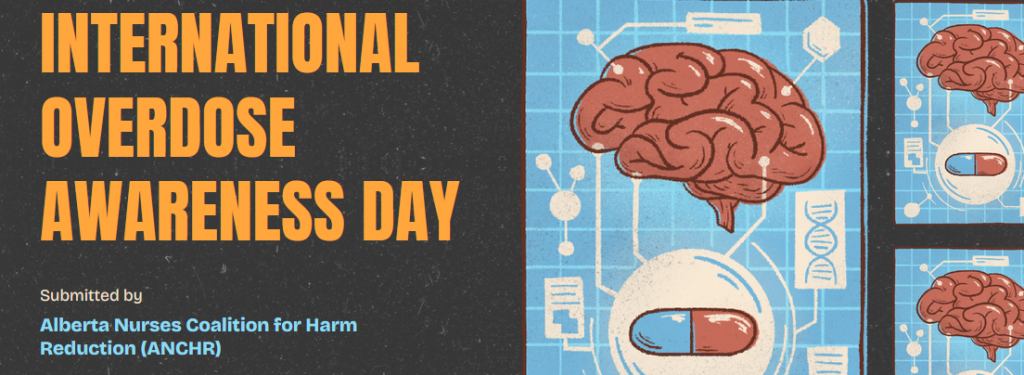
International Overdose Awareness Day on August 31 is a sombre reminder of the ongoing toxic drug crisis we continue to face across Canada. The toxic drug supply has resulted in a public health crisis that has lasted almost 8 years resulting in thousands of preventable deaths. Alberta continues to be deeply affected by this crisis and we have seen it flood into every facet of our practice and our lives. A large proportion of overdoses continue to be attributed to unregulated fentanyl. Everyday almost 22 Canadians lose their lives to an apparent opioid overdose and Alberta continues to be in the top 3 provinces affected by the toxic drug crisis, with one of the highest death rates per 100 000 when compared to other provinces (Federal, provincial, and territorial Special Advisory Committee on the Epidemic of Opioid Overdoses, June 2024; Ledlie, et al, 2024).
Unfortunately, there is no foreseeable end to the toxic drug crisis as we continue to see rising EMS calls, emergency visits, and hospitalizations related to an inadequate public health response to a toxic drug supply.
Despite existing measures to curb overdoses related to the toxic drug crisis, we continue to chase an unpredictable and rapidly changing drug market. Harm reduction measures can reduce the effects of the toxic drug crisis on our communities and these programs must remain available and accessible. Harm reduction is grounded in justice and human rights and aims to minimize the negative health, social, and legal impacts associated with drug use, drug policies, and drug law (Harm Reduction International, 2024). Harm reduction is an important cornerstone in addressing the toxic drug crisis and helps prevent overdoses and complications from substance use including reducing infection and transmission of blood borne illnesses. Examples of harm reduction initiatives include: supervised consumption sites, naloxone kit and sterile supplies distribution, opioid agonist treatment, safer use education, and drug-testing programs.
Although there is increasing politicization of the toxic drug crisis, we must recognize that harm reduction initiatives belong in both community programs and hospital settings. Practicing harm reduction recognizes the inherent value in an individual and allows people who use drugs to access health services to make their own choices without judgement. This approach to care is rooted in human rights and provides dignity and respect to individuals who use drugs through honoring autonomy, choice and acceptance; values that nurses can and should uphold in our practice settings.
As nurses, we have an ethical and professional responsibility to engage with people who use drugs in appropriate and evidence-based ways. Evidence shows that harm reduction helps keep people safe, reduces complications from drug use, and prevents deaths. It is a way to continue to engage with people who use drugs and reduce inequitable health outcomes stemming from marginalization.
Harm reduction has been led by people who use drugs and nurses have worked closely alongside them to advocate for change. Nurses see the direct societal effects of the toxic drug crisis and our profession is in a prime position to affect those directly impacted by this ongoing public health crisis. With increasing utilization of healthcare caused by the toxic drug crisis, the nursing profession is poised to bring our unique skill set, attentiveness, and compassion to support those affected.
To be a part of the solution in addressing the toxic drug crisis, nurses need to learn more and fully engage with harm reduction approaches to care. Nurses should take time understanding more about the toxic drug crisis**, listen to the stories and suggestions of people with lived experience, embrace the families of those we have lost during this ongoing toxic drug crisis, and be open to reflect and adjust our practice to support people who use drugs. From actively dispensing Take-Home Naloxone Kits and sterile supplies, to promoting safer and trauma-informed care spaces, to pushing for more training and resources to address substance use in acute and community settings, nurses can be leaders.
Nurses can make a difference in this ongoing public health crisis if we collectively use our voices on issues. We are a critical part of the solution for the effects of the toxic drug crisis, and with collective efforts and collaboration, we will continue to make a valuable contribution to supporting our communities. We stand beside the families who have lost their loved ones and hold them closely as they navigate this crisis in our communities.
~Alberta Nurses Coalition for Harm Reduction (ANCHR)
**Footnote:
The Canadian Nurses Association has a recent feature on harm reduction in the month of June and July of 2024:
https://www.canadian-nurse.com/blogs/cn-content/2024/06/06/harm-reduction-saves-lives-series
References:
- Federal, provincial, and territorial Special Advisory Committee on the Epidemic of Opioid Overdoses. Opioid- and Stimulant-related Harms in Canada. Ottawa: Public Health Agency of Canada; (2024, June 28). https://health-infobase.canada.ca/substance-related-harms/opioids-stimulants/maps.html
- Harm Reduction International. What is Harm Reduction?. (2024). https://hri.global/what-is-harm-reduction/
- Ledlie, S., Juurlink, D.N., Tadrous, M., Mamdani, M., Paterson, J.M., Gomes, T. (2024). Opioid-related deaths between 2019 and 2021 across 9 Canadian provinces and territories.Canadian Medical Association Journal. 196 (14) E469-E476; DOI: 10.1503/cmaj.231339
